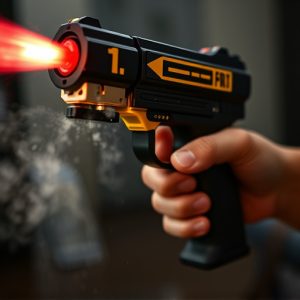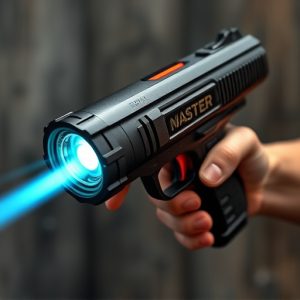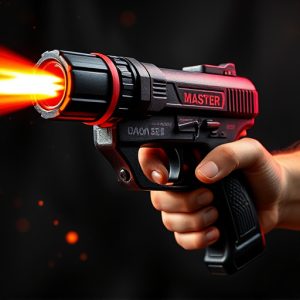Master Blaster Stun Guns: Duration of Muscle Incapacitation and Safety Facts
Master Blaster stun guns deliver powerful electric shocks, temporarily incapacitating targets (3-5 m…….
Master Blaster stun guns deliver powerful electric shocks, temporarily incapacitating targets (3-5 minutes) with muscle spasms and disorientation. Effect duration varies based on model, power output, individual factors, and body structure. While non-lethal, these devices cause pain and require responsible usage, adhering to local laws, and prioritizing safety to protect bystanders.
In today’s world, understanding self-defense tools like stun guns is crucial. This article delves into the science behind muscle incapacitation from stun guns, offering insights into what exactly happens when struck. We explore powerful devices known as Master Blaster stun guns and their efficiency in neutralizing threats. A key focus is the duration of their effects, revealing how long stun gun jolts can immobilize an assailant. Additionally, we discuss factors influencing inactivation time and safety considerations, equipping readers with knowledge about their rights and responsibilities.
- Understanding Muscle Incapacitation: What Happens When You're Stun Gunned?
- Master Blaster Stun Guns: Power and Efficiency
- Duration of Effect: How Long Does it Last?
- Factors Influencing Inactivation Time
- Safety Considerations: Know Your Rights and Responsibilities
Understanding Muscle Incapacitation: What Happens When You're Stun Gunned?
When a person is subjected to a stun gun, also known as a master blaster stun gun, their muscles experience rapid and intense electrical pulses. This stimulation disrupts normal muscle function, leading to a state of temporary incapacitation. The duration of this muscle shutdown varies depending on several factors, including the power output of the device, its contact points with the body, and the target’s overall health and physical condition.
The effects of a stun gun are designed to be non-lethal, but they can cause significant discomfort and temporary paralysis. During the incapacitation period, which typically lasts from several seconds to a minute or more, the individual may experience muscle spasms, loss of balance, and difficulty moving. Understanding these physiological responses is crucial for both those considering carrying self-defense devices like master blaster stun guns and law enforcement officials tasked with managing situations involving such equipment.
Master Blaster Stun Guns: Power and Efficiency
Master Blaster Stun Guns, known for their impressive power and efficiency, have become a popular choice among individuals seeking non-lethal self-defense solutions. These devices emit a powerful electric shock that temporarily incapacitates the target, providing users with valuable time to escape dangerous situations. The effectiveness of a Master Blaster stun gun lies in its ability to deliver a strong jolt, often described as a “stun” or “knockout” effect, which can disable an assailant for several minutes.
This specific model distinguishes itself by featuring advanced technology that ensures a quick response time and consistent performance. The high-voltage output disrupts the target’s muscular control, leading to muscle incapacitation that can last from 3 to 5 minutes, depending on various factors like the device’s settings and the recipient’s physical condition. This duration is long enough for an individual to retreat to safety or call for help, making Master Blaster stun guns a reliable tool for personal protection.
Duration of Effect: How Long Does it Last?
The duration of effect from a master blaster stun gun can vary depending on several factors, including the model, power output, and the individual’s physical attributes. On average, a stun gun’s incapacitation period lasts for about 3 to 5 minutes. During this time, the targeted person will experience muscle spasms, disorientation, and temporary paralysis.
These weapons use an electric current to disrupt muscular control, leading to loss of balance and strength. The effect is designed to subdue the target long enough for law enforcement or security personnel to take control and ensure safety. However, it’s important to note that some advanced models can provide longer durations, up to 10 minutes or more, offering enhanced protection in high-risk scenarios.
Factors Influencing Inactivation Time
The duration of muscle incapacitation from a stun gun, including that of popular devices like the Master Blaster Stun Gun, varies significantly based on several factors. These include the power output and design of the weapon, the target’s overall health and physical condition, and their resistance to electrical shock. Higher voltage and current outputs generally result in longer periods of immobilization, as they disrupt nerve signals more effectively. However, even with powerful devices like the Master Blaster Stun Gun, the effects are temporary—typically lasting from a few seconds up to several minutes.
Other considerations include the location of the stun gun contact points on the body and the target’s muscle mass. For instance, striking larger muscles or nerve clusters can lead to longer inactivation times compared to smaller areas. Moreover, environmental conditions like temperature and moisture can also influence the effectiveness and duration of the stun gun’s effects, as electrical conductivity varies with these factors.
Safety Considerations: Know Your Rights and Responsibilities
When using a stun gun, like the popular Master Blaster model, understanding the safety considerations is paramount. It’s crucial to know that while stun guns are designed for self-defense, their use comes with rights and responsibilities. Users must be aware of local laws regarding stun guns, as regulations vary widely from one region to another. It’s essential to check and comply with these laws to avoid legal repercussions.
Additionally, safety should never be taken lightly. Stun guns emit an electric shock that can incapacitate a target temporarily, but they are not weapons of mass destruction. Users should be mindful of their surroundings, ensuring no bystanders are affected. Responsible use involves aiming correctly and only applying enough force to disable the threat, typically a few seconds of immobilization. Knowing your rights and practicing safe usage goes hand in hand to ensure you’re protected without endangering others.
The understanding of muscle incapacitation from stun guns, particularly the potent effects of Master Blaster stun guns, is crucial for both users and those in law enforcement. The duration of these effects varies based on several factors, emphasizing the importance of knowing your rights and responsibilities when carrying a stun device. In summary, while stun guns offer a non-lethal self-defense option, their effectiveness and safety depend on accurate usage and an awareness of the temporary but powerful inactivation period they induce.


